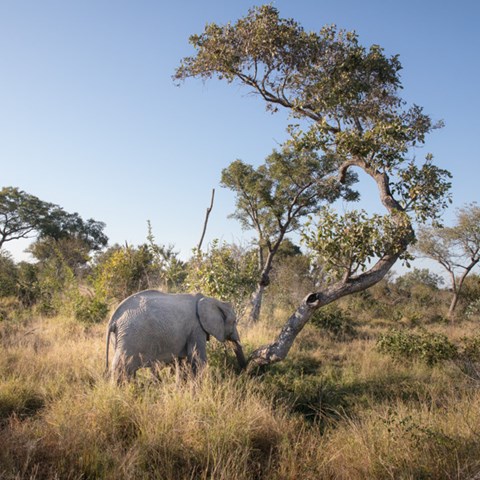Contact
Department of Wildlife, Fish and Environmental Studies

Protecting and restoring populations of wild animal species can help keeping global temperature rise below the critical threshold of 1.5 degrees, while at the same bending the negative biodiversity curve, a new study published in the Nature Climate Change shows.
Wild animals have a huge impact on the ecosystems they live in and they play a central role in the carbon cycle on land, in fresh water and in the seas. They spread the nutrients and seeds that help the dispersal and growth of carbon-dense plants, they bind carbon in their bodies and they limit carbon emissions from wildfires with their grazing, just to name a few examples.
A new study by fifteen researchers from eight different countries shows that the conservation and restoration of populations of key wild animal species around the world can improve the capacity of ecosystems to capture and store carbon, which plays a crucial role in limiting climate change. The study describes how the restoration of these wild animal populations could “supercharge” ecosystem carbon sinks and help to keep the global temperature rise below the critical threshold of 1.5 degrees.
“Our results emphasize opportunities for win-win situations, where restoration of biodiversity, especially large mammals, can be an effective climate action. Ecosystems with these wild mammals store more carbon than without them. However, we do not have much time because we quickly lose wild animals in many parts of the world,” says Joris Cromsigt, Associate Professor at the Swedish University of Agriculture, SLU, and co -author of the study.
The international team highlights how wild animals, through their interaction with the environment, are the missing central link between biodiversity and climate, and that the restoration of their populations is one of the best nature-based climate solutions.
The study presents data showing that the protection or restoration of populations of nine wild animal species (or groups of species) - sea fish, whales, sharks, wolves, wildebeest, sea otters, musk oxen, African forest elephants and American bison - together could facilitate an additional capture of 6.41 billion tonnes of carbon dioxide (GTCO2) per year. This is more than 95 percent of the amount needed each year (6.5 GTCO2) to achieve the global goal of removing 500 GTCO2 from the atmosphere by the year 2100 to reach the Paris targets.
These nine wild animal species have an average lifespan of between 20 and 200 years. Focusing on the protection and restoration of such long-lived species is advantageous as it ensures significant long-term effects on carbon storage until the end of the century.
“However, if these species were to disappear instead, the ecosystems they live in could turn from carbon sinks to carbon sources,” says Joris Cromsigt.
The species dealt with in the new article are only a fraction of wild animal species that could help supercharge carbon storage of the ecosystems they live in. The paper highlights more potential species, but the key is not to limit them to protected areas, the researchers say.
“Accepting wild animals as part of climate action allows us to think bigger and to move away from our current, static, understanding of conservation and focus on protecting limited areas. Moreover, we highlight novel nature-based climate opportunities beyond the current focus on planting trees. What is needed for this are dynamic landscapes and marine environments and new models for coexistence of humans and wildlife,” says Joris Cromsigt.
Schmitz, O.J., Sylvén, M., Atwood, T.B. et al. Trophic rewilding can expand natural climate solutions. Nat. Clim. Chang.(2023). https://doi.org/10.1038/s41558-023-01631-6
Joris Cromsigt.
(Click for high resolution image.)
Photo: Susanna Bergströ, SLU